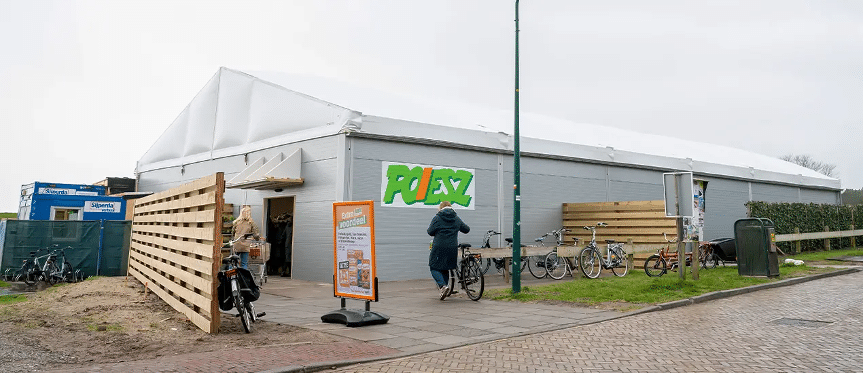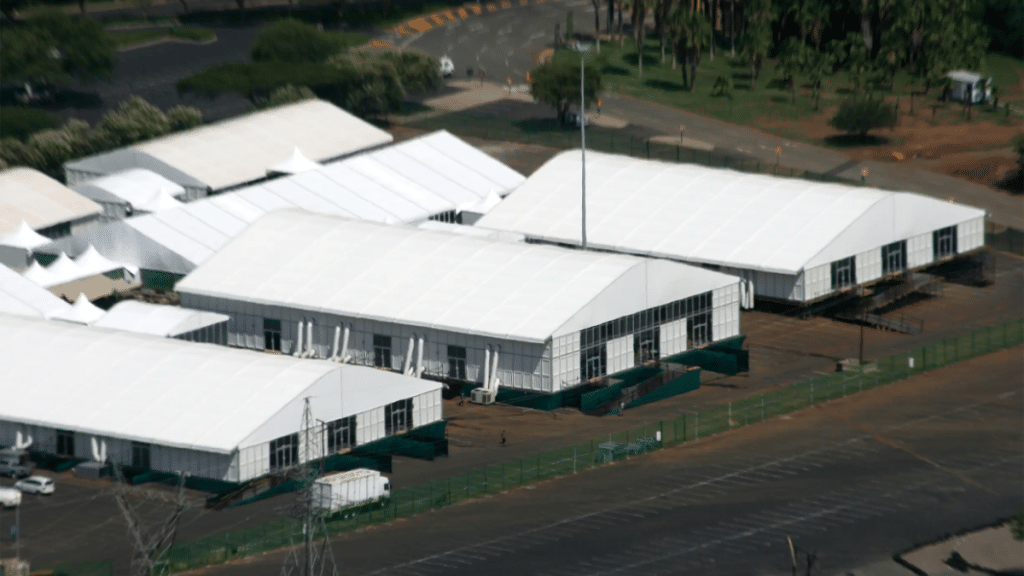Are you looking to expand the factory’s workplace and storage areas? Do you frequently change your warehouse location? If your new building is a permanent reinforced concrete structure, it would indeed be a complicated undertaking. Not only would there be costs involved, but you would also face difficulties with setup time and burdensome local regulations for permanent buildings.
It’s time to change your approach and consider a new, cost-effective solution: the industrial canopy. Let’s take a look at everything it has to offer.
What Is an Industrial Canopy?
An industrial canopy is a large, clear-span tent which provides ample interior space and has no central columns, allowing you to zone the work area. And like a permanent building, it can protect facilities and cargo from rain and sunlight due to its fabric cover. Moreover, its solid metal structure enables it to withstand harsh weather conditions such as strong winds and heavy snow.
Popular Applications by Industry Canopy
Industrial canopies are widely used for their reliability and convenience. They are typically used in the following scenarios:
- Construction: An industrial canopy is perfectly adapted to the mobility of construction sites due to its quick set-up. This structure can be deployed as a temporary construction tent or as an on-site office.
- Logistics and Transportation: It is an ideal solution for temporary use, such as for warehouses, loading and unloading areas, or as a temporary vehicle parking shelter.
- Manufacturing: The structure performs the same function as the reinforced concrete building, providing utilities such as equipment protection and raw material stacking sheds.
- Agriculture and Farmers’ Markets: This product’s versatility extends beyond agricultural machinery shelters, offering significant functionality as an agricultural trading area.
Key Factors to Consider When Choosing an Industrial Canopy

After reading the basic introduction, you might already be interested in building an industrial canopy. There are several factors that you should carefully take into consideration. Keep reading to find out more.
Use Purpose
Firstly, you should decide on the intended use, as this will significantly influence your choice of industrial canopy.
If it is to be used as an industrial warehouse canopy, the most important things would be a waterproof, light-blocking cover and a hardened floor to protect your cargo from damage. And pay close attention to the number and size of the entry if you need some small machinery to load, transport, and unload the cargo.
As well as being used as a warehouse, the industrial canopy can also be used as a workplace. If you have a large number of workers in the canopy, you should consider ventilation. Normal solutions include more entrances, extractor fans, and air conditioners.
Size and Layout
Then you need to measure your site and start your industrial canopy design. Decide where to build it, and reserve space for future expansion. Opting for a modular canopy design would considerably reduce the construction time and difficulty of any future extensions.
If your canopy’s intended width is less than 12 metres, a frame tent made of smaller profiles would suffice. It would cost less but would still be solid enough.
A large industrial canopy is better suited to sites wider than 12m, and a clear span tent will meet your high standards. Made of larger columns and beams, it provides greater structural integrity, making it the best choice for large spans.
If you want an extra-large canopy, wider than 50m, with a distinguished appearance to impress your clients, don’t miss the revolution tent. As robust as the clear span tent, it catches people’s eyes with its modern, artistic roof.
Material and Durability
The material is the main factor that determines the durability of an industrial canopy. It consists of two main parts: the structure and the cover.
The structure can be made of steel or aluminium alloy. The aluminium alloy is much lighter than steel, which makes the large span possible, with some spans reaching up to 70 metres.
There is also a range of cover options, such as PVC, PE, polycarbonate sheets and metal sheets. For waterproofing, UV protection, mould resistance, fire retardance and tear resistance, we recommend PVC as your first choice, as it performs well in these scenarios yet is comparatively inexpensive.
Finally, you need to consider the local working conditions, such as wind speed and snowfall. The quality of different canopies from different manufacturers can vary greatly. Therefore, you should carefully review the relevant data.
Shelter Structures’ canopies can withstand wind speeds of up to 120 km/h and snow loads of up to 51 kg/m², which is an exceptional quality compared to other products. Furthermore, the structure has a lifespan of up to 20 years and the cover up to 5 years, setting it apart from other products.
Mobility and Installation
If your work mainly involves construction or temporary storage, you will place a high value on mobility and ease of installation. In that case, it would be wise to use an industrial canopy with a modular design. This means that the profiles are prefabricated in the factory, so only on-site installation is required. This would not take several weeks or even months as it would for a permanent building.
Also, Shelter Structures’ professional construction team, which has many years’ experience in building small or large industrial canopies, would greatly shorten the setup time.
Local Regulations
Remember to check your local regulations, including building and safety standards, fire requirements, and temporary building permits. Taking the time to familiarize yourself with all the regulations will prevent any problems during the construction process.
Budget
The upfront cost includes the cost of acquiring equipment (canopies and licences), transportation costs, and installation costs. As one-time costs have a sunk cost nature, they need to be related to subsequent depreciation.
Therefore, reusability is important. The main factors are a modular design and adaptability to various working conditions. This means that initial costs are spread over multiple project cycles, reducing single-use costs.
Furthermore, maintenance costs should also be considered. The cover often needs to be fixed or replaced. Unexpected things sometimes happen, so you should reserve some budget for this eventuality.
Conclusion
After reading this article, you should have a better understanding of industrial canopies and how to choose one. If you are planning to build a canopy for your next programme, you may also be interested in finding out which manufacturer to work with.
Shelter Structures provides a range of canopies suitable for various scenarios, including industrial use. All of our canopies have a modular design and are made from high-quality materials, making them not only durable, but also adaptable to all kinds of working conditions. Furthermore, they are easy and quick to disassemble, transport, and assemble, making them perfect for temporary storage or workspaces. Compared with a permanent building, an industrial canopy is much cheaper and saves a lot of time and effort.
Contact us today to build an industrial canopy and help your business thrive!
